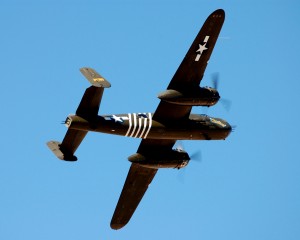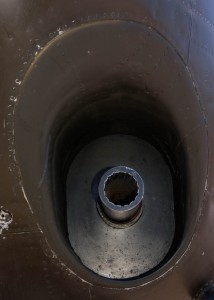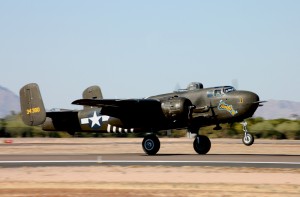
The B-25H Mitchell bomber, operated by the Warbirds Unlimited Foundation Inc., wears the WWII nose art of Barbie III. The aircraft is one of 1000 “H” models built during WWII.
By Bob Shane
Barbie III, the only B-25H Mitchell bomber flying in the world, will be based at Centennial Airport (APA) from July 15 to Sept. 15. The aircraft will be available for tours, providing an opportunity for the public to be a part of an unforgettable flight experience.
Dick Jones will be one of the pilots flying Barbie this summer. Jones’ fate was sealed at the age of 2; his favorite toy was an airplane. His love of aviation and flying later evolved into a particular fondness for World War II aircraft. Jones was a member of the Colorado wing of the Commemorative Air Force (then known as the Confederate Air Force) in the early 1980s, and in 1984, he invested in a T-6. He based the Spanish Lady at Centennial Airport for years. He received his type rating in the B-25 early this year.
Manufactured in Englewood, Calif., in 1943, Barbie was the number two prototype of the H model; North American Aviation built 1,000 of the H models. This particular B-25 served stateside until 1947, when the government sold it to the Bendix Corporation, which used it as a test aircraft in the development of new landing gear systems for jet fighters. Bendix operated the aircraft for a decade, after which it had various owners. In 1969, the aircraft ended up on the auction block; an Illinois farmer acquired the plane for the winning bid of $3,500. He flew it to his farm in Plainfield where it was relegated to a sandbox toy.
Ten years elapsed before a dedicated and adventurous band of aviation enthusiasts, the Weary Warrior Squadron, discovered the bomber. Eager to bring the derelict piece of history back to life, the group purchased the aircraft from the farmer. After two subsequent engine failures, in 1981 the bomber successfully flew off the farm to begin its full restoration.
The group named the bomber Barbie III after a cannon-nosed H model that had been assigned to the 1st Air Commando Group, which had seen action in India and Burma. A member of the restoration team, Jerry Macomber, painted the aircraft as closely as possible to the original Barbie III.
It took the Weary Warriors 10 years to restore the airplane, at an estimated cost of $400,000. The bomber has a solid nose with a replica 75mm cannon and is the only airworthy B-25H model in the world.
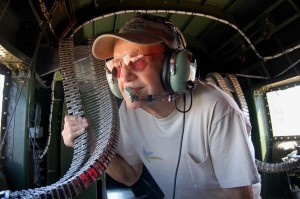
Ray Snyder is part of the regular crew. At age 84, he has many years of experience aboard WWII warbirds.
After the completion of the plane’s restoration, the Weary Warriors took the warbird to air shows during the summer months, and for a sizeable donation, offered rides to the public. In the winter it was too cold to fly, so the B-25 spent the season idle, tucked away in a hangar until spring.
In 2005, Jack Fedor, a member of the Weary Warrior Squadron and part owner of the medium bomber, moved to Fountain Hills, Ariz. Entertaining the possibility of basing the B-25 in Arizona when it was too cold to fly in the Midwest, Fedor found himself talking to airport personnel at Falcon Field Airport (FFZ) in Mesa, Ariz. They encouraged flying the rare WWII bomber to the Copper State.
The B-25H soon left Illinois, relocating to the city ramp behind Anzio’s Landing, an aviation-themed Italian restaurant at Falcon Field.
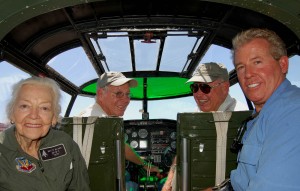
L to R: WASP Betty Blake, Dick Jones (pilot), Sam Korth (pilot) and Bruce Blake (Betty Blake’s son) were all smiles after a great ride in Barbie III.
“Flying the B-25 is a lifetime dream that has just fallen in my lap,” Fedor said. “Many feel that this must be an ego trip. No ego, just a lot of hard work with the reward being all of the interesting people I meet.”
Since 1991, the Weary Warriors, and now the Warbirds Unlimited Foundation Inc., a nonprofit educational group, have been providing the public with the opportunity to experience what it was like to fly in a rare WWII bomber. More than 1,500 people have flown on Barbie.
Restored back to its wartime configuration, Barbie is a flying monument to those who built, crewed and serviced U.S. military aircraft during WWII. The bomber serves as a reminder of the sacrifices made by the nation’s veterans and honors their service.
People take the flights for many reasons. They provide an opportunity to relive an experience, reconnect with the past or simply see what a bygone era was like. Very often, the ride is a gift from a family member.

L to R: Dick Jones, Betty Blake and Jack Fedor posed for a photograph after Blake was presented with an official B-25H hat.
On Memorial Day weekend, the Barbie crew flew a special WWII pilot. Betty Blake, now 87, was a member of the Women Airforce Service Pilots. Blake flew everything from trainers and transports to bombers and fighters. In all, she flew 36 different aircraft types. Most of her ferry flights were from Long Beach, Calif., to various military bases across the U.S.
Blake’s ride in Barbie was a particularly sentimental and emotional experience. The takeoff brought tears to her eyes as it rekindled fond memories of flying with her late husband, George, who was a B-25 pilot. Soon after reaching cruising altitude, Blake began to note the changed landscape.
“The area was all desert when I used to fly over it,” said Blake. “Now it’s a sea of tile roofs with tiny swimming pools.”
A smile appeared on her face as she confessed, “We liked to buzz things; we always flew low-level. Flying the same cross-country route three times a week would get dull.”
Blake still has a copy of a 1943 memorandum issued by Gen. “Hap” Arnold, the commanding general of the Army Air Forces, citing the receipt of numerous civilian complaints from all over the country regarding “hazardous flying” (buzzing) by pilots flying military aircraft. Arnold stated, “This hazardous flying must be stopped and stopped now.”
One thing is certain, the years haven’t mitigated Blake’s feisty spirit or her recollection of what flying was like as a WASP in WWII.
The group schedules rides during the week and most weekends. The B-25 can accommodate six passengers plus the flight crew. Passengers are guaranteed 30 minutes in the air, which usually works out to be a total of 45 minutes on board the airplane.
If old airplanes like the B-25 are to be kept airworthy, a successful financial plan is a requisite. Every year, the cost of maintaining the aircraft in flyable condition increases. Selling souvenirs and offering rides sustains the flight operation. It’s an all-volunteer show; every penny taken in goes back to the airplane and all donations made are tax deductible.
In addition to the B-25, the Warbirds Unlimited Foundation Inc. is in the process of restoring, preserving and operating other WWII aircraft. According to Fedor, “Every airplane will be flyable.”
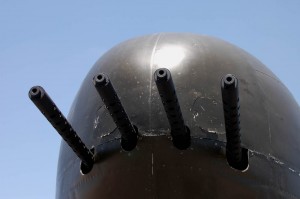
The B-25H was armed to the teeth with four .50 caliber machine guns in the nose and 14 .50 calibers in total.
In December 2007, Warbirds Unlimited added a Grumman TBM-3 Avenger to its lineup; the plan is to put the WWII torpedo bomber on the ride program in the fall of 2008. It will also accompany the B-25H to any air shows attended by the medium bomber.
The foundation is also currently involved in a major restoration project—the 1942 Boeing Stearman PT-17 flown by the world-renowned aerobatic champion and stunt pilot Art Scholl in the pioneering IMAX movie, “To Fly!” The plane has been in pieces and dormant for more than two decades, but Fedor and his team are shooting for a thorough restoration by the end of 2008. Once it returns the plane to pristine condition, wearing its original training markings, the foundation will be able to offer the public another flying opportunity, this time in an historic aircraft type that was used to train many of the pilots of WWII.
For more information regarding B-25 rides, making donations or the volunteer program, visit [http://www.warbirdsunlimited.org].












